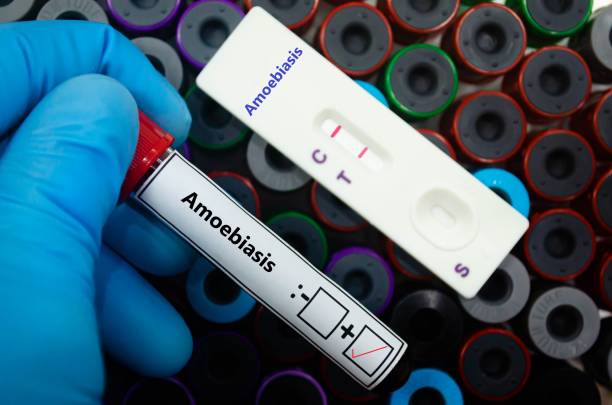
Blood sample of patient positive tested for amoebiasis by rapid diagnostic test.
Amoebiasis Overview
Amoebiasis is an intestinal illness caused by the parasite Entamoeba histolytica. The infection primarily affects the colon and is transmitted through the consumption of contaminated food or water. It is more common in areas with poor sanitation, especially in tropical regions.
Causes
Amoebiasis is caused by the protozoan parasite Entamoeba histolytica. It spreads through:
- Ingestion of food or water contaminated with feces containing the cysts of the parasite.
- Person-to-person contact, especially in conditions of poor hygiene.
- Flies and other insects that can transport cysts from feces to food.
- Sexual transmission (especially in anal-oral contact).
Risk Factors
- Poor sanitation: Living in or traveling to regions with inadequate sanitation increases the risk.
- Crowded living conditions: Close quarters can lead to higher transmission rates.
- Malnutrition: Weak immune systems make people more susceptible to infection.
- Institutional settings: Such as prisons or refugee camps with poor hygiene practices.
- Sexual practices: Engaging in anal-oral sexual practices can increase the risk.
Symptoms
Symptoms of amoebiasis can vary from mild to severe and often develop within 2 to 4 weeks after exposure. They include:
- Mild symptoms:
- Abdominal cramps
- Diarrhea (which may be watery or bloody)
- Fatigue
- Weight loss
- Flatulence and bloating
- Severe symptoms (Amoebic dysentery):
- Severe abdominal pain
- Bloody, mucus-filled stools
- High fever
- Painful bowel movements (tenesmus)
In rare cases, the parasite can spread outside the intestines, leading to more severe complications.
Diagnosis
- Stool tests: The most common method, identifying E. histolytica cysts or trophozoites in the stool.
- Serology (antibody tests): Useful in identifying invasive amoebiasis, especially when the parasite has moved to other organs.
- Colonoscopy or sigmoidoscopy: Performed if stool tests are inconclusive, allowing visualization of ulcers or collection of tissue samples.
- Imaging tests: Ultrasound, CT scans, or MRI may be used if liver abscesses are suspected.
Treatment
- Antibiotics: Amoebiasis is treated with specific antibiotics that target both the cysts and the trophozoites. Common treatments include:
- Metronidazole or tinidazole: Used to kill the active trophozoites.
- Paromomycin or diloxanide furoate: To eliminate cysts from the intestines after initial treatment.
- Drainage: In cases of liver abscesses, drainage may be necessary if the abscess is large or does not respond to antibiotics.
Complications
Without treatment, amoebiasis can lead to severe complications such as:
- Amoebic liver abscess: The parasite can spread to the liver, causing abscesses and damage.
- Perforation of the colon: Invasive infection can lead to intestinal perforation, causing peritonitis.
- Spread to other organs: Rarely, the parasite may infect other organs, such as the lungs, brain, or heart.
Precautions and Prevention
- Safe drinking water: Drink bottled or boiled water in regions where amoebiasis is common.
- Proper sanitation: Avoid eating food from street vendors, particularly in endemic areas. Wash fruits and vegetables thoroughly before eating.
- Hand hygiene: Wash hands regularly, especially after using the bathroom and before handling food.
- Avoid high-risk sexual practices: Practice safe sex, especially if engaging in activities that may increase exposure to contaminated fecal material.
Self-Care and Management
- Hydration: Replace lost fluids and electrolytes, particularly in cases of diarrhea. Use oral rehydration solutions (ORS) if necessary.
- Nutritional support: Consume light, easily digestible food, and avoid heavy, greasy meals during recovery.
- Follow the full course of medication: Complete the prescribed antibiotics to ensure the infection is fully eradicated.
- Rest: Get adequate rest to help the body fight off the infection.
Amoebiasis is generally preventable through good hygiene and proper sanitation practices. Early treatment is essential to avoid complications.








